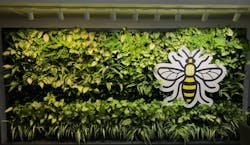Understand horticultural LED SPD for optimum plant wall experience
A group of solid-state lighting (SSL) manufacturers and noted researchers has released a study titled “Lighting Green walls — finding the optimum CCT and SPD of white light sources.” The research project was designed by Dr. Amardeep Dugar of Lighting Research and Design working in partnership with Professor Peter Raynha, of University College London, and David Gilbey of NDY Light. Xicato, Wonderwall, and Lumenpulse Alphaled provided LED light sources and luminaires along with plant walls for the test. The research shows the need for matching spectra to application and that SSL for plants must be different if the goal is appearance as opposed to yield of, say, vegetables or cannabis.
Plant walls indoors in places such as commercial office atriums are increasingly popular as a way to add beauty and ambience to a space and even to improve air quality. In many, if not most, cases artificial lighting provides the primary energy source of the plants in such a wall. And while plant walls may not be deemed as noble an undertaking as is feeding a growing populace, the walls are very instructive in terms of understanding the interaction of SSL spectra and plant response.
We’ve heard similar messages before. For example, at our Horticultural Lighting Conference 2018, keynote speaker Erik Runkle of Michigan State University discussed spectral power distribution (SPD) for flowers to be sold on the retail market. Some light recipes tested yielded taller plants, but those were less durable and actually deemed less attractive.
In the plant wall study, the researchers worked with six different cultivars over a five-month period. The project involved tests of three different lighting installations at CCTs of 3000K, 4000K, and 5600K within an interior room at University College London. A total of 106 volunteers participated in evaluating the appearance of the walls. The volunteers were selected based on having some level of experience in architecture, lighting design, landscaping, and related fields.
The evaluation was unique in that it ultimately involved both judging the appearance and health of the plants and also the general ambience related to color temperature and SPD in a space. The volunteers were instructed in evaluating plant characteristics in terms of leaf and stem health. And some results were easily discerned. Plants under the 3000K lighting had longer and more slender stems. This attribute was associated by the researchers to having more red energy in the SPD. In this case, shorter and stronger structures would be preferred.
At the other end of the spectrum, the plants exposed to 5600K light were arguably the most robust of the plants studied. Still, 5600K is a compromised experience for people in such a space. The volunteers ultimately judged the 4000K option to deliver the best combination of plant growth and appearance balanced with ambience.
The paper published by the researchers digs far deeper into the science at hand and the different cultivars. You can download the paper for perusal directly.
We will again have presentations on the impact of SSL on plant appearance in yield at our HortiCann Light + Tech conference that will take place Oct. 20–21. The event will be an online virtual conference this year due to the COVID-19 situation. We will also have sessions that dig deeper into the AgTech world including topics such as the use of artificial intelligence to improve plant yield.
For up-to-the-minute LED and SSL updates, why not follow us on Twitter? You’ll find curated content and commentary, as well as information on industry events, webcasts, and surveys on our LinkedIn Company Page and our Facebook page.

Maury Wright | Editor in Chief
Maury Wright is an electronics engineer turned technology journalist, who has focused specifically on the LED & Lighting industry for the past decade. Wright first wrote for LEDs Magazine as a contractor in 2010, and took over as Editor-in-Chief in 2012. He has broad experience in technology areas ranging from microprocessors to digital media to wireless networks that he gained over 30 years in the trade press. Wright has experience running global editorial operations, such as during his tenure as worldwide editorial director of EDN Magazine, and has been instrumental in launching publication websites going back to the earliest days of the Internet. Wright has won numerous industry awards, including multiple ASBPE national awards for B2B journalism excellence, and has received finalist recognition for LEDs Magazine in the FOLIO Eddie Awards. He received a BS in electrical engineering from Auburn University.





